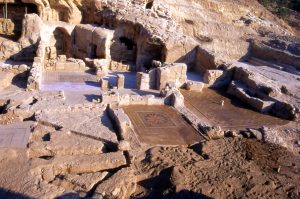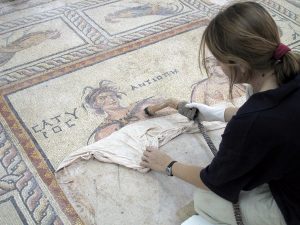The mosaics at the beginning of the project
The project developed within the framework of the in situ conservation program carried out by CCA at Zeugma, and involved the restoration of 48 mosaic floors, mostly polychrome and figurative, for a total surface of 850 m2, which had been lifted between 1996 and 2002 and deposited in the Gaziantep Museum. In June 2000, the mosaics in small fragments were found stacked in every available space in the small Museum, including the garden that surrounds it. This large number of fragments was in alarming preservation conditions due to prolonged exposure to the outdoor environment, inadequate lifting and transportation methods, and poor storage conditions. In addition to this, insufficient documentation prior to lifting made it hard to identify the fragments. The adhesives used to apply facing for lifting were in many cases becoming detached, causing loss of tesserae and lifting of whole sections of facing, which had torn and stiffened as a result of unfavorable environmental conditions.
The first conservation program, carried out by the CCA at Gaziantep in December 2000, was entirely focused on the recovery of fragments from the garden and basement of the Museum, and their placement in the two restoration laboratories built by the PHI in the Museum. During this phase, examination of the fragments’ rear allowed to create a coherent whole, and to establish the identity of each mosaic, the number of fragments of each and the approximate dimensions. A first documentation map was elaborated on the basis of the excavation photos, with the name of each mosaic, domus of provenance, year of lifting, number of pertinent fragments and dimensions. Thanks to this first documentation effort it was possible to proceed with the next steps, planning the entire process in detail and commencing treatment in March 2001.










